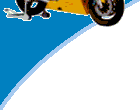




|
Kit Details |
Extra tools and supplies needed to build the Rikuo RT-II:
| Drill Bits |
|
||||||||||||||||||||||||
| Adhesives | 12 minute epoxy for assembling die-cast parts. Gives you more working time than CA glue and I think a stronger bond. CA glue for wheel spoke assembly. | ||||||||||||||||||||||||
| Tools | Moto tool (ie. Dremel) and polishing accessories. Used for
drilling and polishing die-cast metal parts. |
Priming - all done with Plasti-Cote Grey Sandable Primer
Body Colour - substituted A-21 with Toyota '85-87 Light Metallic Blue
(LMB) touch up paint
Drilling - I took all the metal parts and drilled the appropriate holes
before beginning construction. This way the parts are ready when I need them Be sure
to double check the instructions so you don't miss any.
General Notes:
Priming - all done with Plasti-Cote Grey Sandable Primer Body Colour - substituted A-21 with
Toyota '85-87 Light Metallic Blue (LMB) touch up paint Drilling - I took all the metal parts and
drilled the appropriate holes before beginning construction. This way the parts are ready when I need
them Be sure to double check the instructions so you don't miss any.
Step #1 - Engine Assembly
In order to paint the starter (M-11) nice and cleanly. I slipped the end of the starter into a brass tube to mask the end. I used Maskol to cement the starter into the tube. I then primed with and painted with TS-14 Black.
The left case had some pits in it, so I filled them with spot putty. Sanded and primed. Painted with LMB.
Bend PE-19 into shape with the engine positioned in the frame. This why you'll get the proper shape. You have to either cut the rivets shorter or drill the holes deeper to install PE-19. I did the latter.
Step #2 - Transmission Setting
In order to properly drill the holes for mounting the transmission (M-14)
I CAed a 1mm think piece of cardboard to M-14. Once the hole locations were marked and
drilled, I removed the cardboard from M-14.
To properly position A-2 on the frame, I used the rear guard D3-3 to find the correct place to cement A-2. Otherwise you'll just be guessing.
The oil tank (B-4) needs four holes drilled in it. See Step #3-3 for the position of the three holes not shown in Step #3-1.
Before installing the engine, make sure the brake crank (M-16) will not hit the frame. For me the brake crank and the frame want to occupy the same space. I didn't notice this before, but the instructions do show part of the frame carved away. The brake crank lines up dead center on the frame tube for me. The only thing I can think of is cut through and epoxy in a piece of tubing for the part to pass through. This way the frame's strength isn't compromised. As a bonus, this would help support the heavy engine and transmission. I inserted a piece of 7/64" ID brass tubing in the frame so the brake crank could pass through it.
Also, I added small 0.010" thick triangle pieces of sheet styrene on either side of the front engine support to remove any sideways play of the engine.
![]()
Step #4 - Rear Brake Rod & etc. Setting
Step #6 - Lever, Sub Stay & etc. Assembly
1) Right side sub stay & etc. setting
2) Left side sub stay & etc. setting
The wheels may look difficult, but the provided jigs makes it as simple as can be.
To cut the spokes to the length, I made a jig from brass tubing and rod. I slide the rod into the tubing so that a 25mm deep cavity was created. Then I just slide in the wire and cut to length.
After the spokes and wheels were assembled, I added some more CA to the where the spokes enter the hubs to provide extra strength.
There are no valve stems, so I drilled through the wheel and insert short lengths of #28 wire. A drop of CA on the end simulates the air cap.
Step #8 - Wheel Assembly
5) Break off the hub stay
6) Cut off the wheel stay after cementing the rim
7) Tire setting
Step #10 - Rear Fender & Wheel Setting
Step #11 - Side Box Setting1) Right side box setting
2) Left side box & main stand setting Step #13 - Horn & Guard Setting
1) Horn & guard stay setting
2) Front guard setting
3) Rear guard setting
Step #14 - Front Fender Assembly
Step #15 - Front Fork & etc. Assembly1) Front fork processing
2) Front fork & headlight assembly
Step #16 - Front Wheel & etc. Setting
Step #17 - Handlebar AssemblyStep #18 - Frame Setting
Step #19 - Side Stand SettingStep #20 - Wiring
Step #21 - Fuel Tank AssemblyAfter cementing the tank halves together, I cemented a strip of sheet styrene on the inside of the seam for added strength.
Step #22 - Fuel Tank & Seat Setting
 |
|||||||||||||||
|
|||||||||||||||
 Home - News - Tips - Gallery - Workshop - Kits - Links - What's New? - Site Index |



